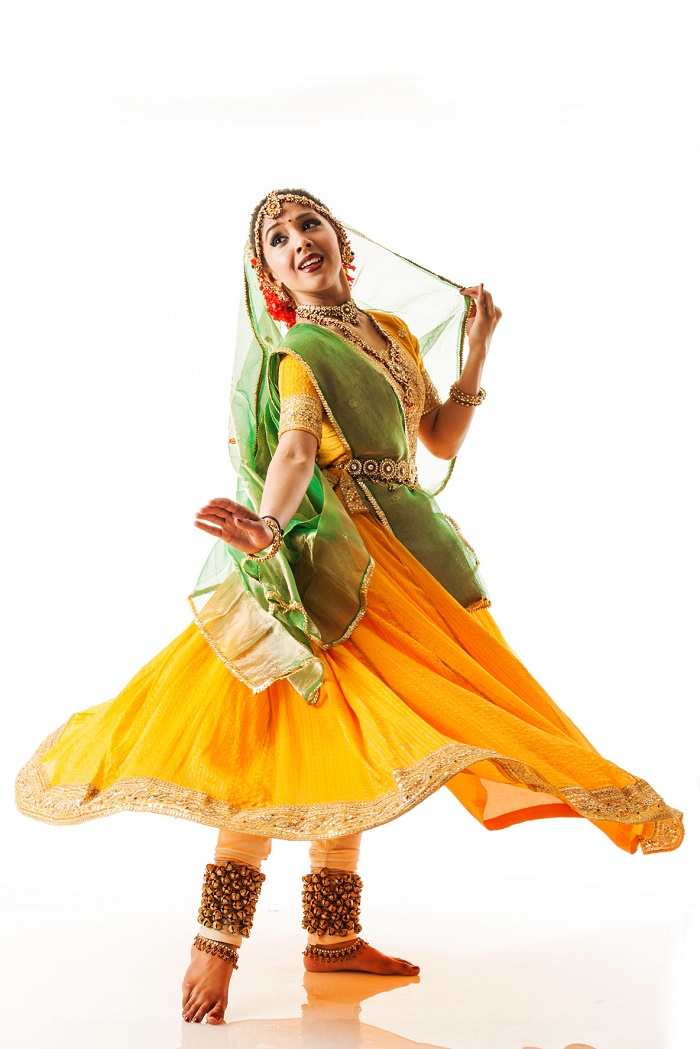Kathak is one of the main genres of ancient Indian classical dance and is traditionally regarded to have originated from the travelling bards of North India referred as Kathakars or storytellers. These Kathakars wandered around and communicated legendary stories via music, dance and songs quite like the early Greek theatre. The genre developed during the Bhakti movement, the trend of theistic devotion which evolved in medieval Hinduism. The Kathakars communicate stories through rhythmic foot movements, hand gestures, facial expressions and eye work. This performing art that incorporates legends from ancient mythology and great Indian epics, especially from the life of Lord Krishna became quite popular in the courts of North Indian kingdoms. Three specific forms of this genre that is three gharanas (schools), which mostly differ in emphasis given to footwork versus acting, are more famous namely, the Jaipur gharana, the Benaras gharana and the Lucknow gharana.
History & Evolution
The roots of this dance form trace back to Sanskrit Hindu text on performing arts called ‘Natya Shastra’ written by ancient Indian theatrologist and musicologist Bharata Muni. It is presumed that the first complete version of the text was completed between 200 BCE to 200 CE, but some sources mention the timeframe to be around 500 BCE and 500 CE. Thousands of verses structured in different chapters are found in the text that divides dance in two particular forms, namely ‘nrita’ that is pure dance which comprise of finesse of hand movements and gestures, and ‘nritya’ that is solo expressive dance that focuses on expressions.
Russian scholar Natalia Lidova states that ‘Natya Shastra’ describes various theories of Indian classical dances including Tandava dance of Lord Shiva, methods of acting, standing postures, gestures, basic steps, bhava and rasa. Mary Snodgrass states that the tradition of this dance form is traced back to the 400 BCE. Bharhut, a village in the Satna district of Madhya Pradesh, India stands as a representative of early Indian art. The 2nd century BC panels found there illustrates sculptures of dancers in different vertical poses with arm positions that resemble Kathak steps, many of which reflect the 'pataka hasta' Mudra. The word Kathak is deduced from the Vedic Sanskrit term ‘Katha’ which means ‘story’ while the term kathaka that finds place in several Hindu epics and texts means the person who tells a story. Text-based analysis indicates Kathak as an ancient Indian classical dance form that presumably originated in Banaras or Varanasi and then spread its wings in Jaipur, Lucknow and many other regions of north and northwest India.
Association with Bhakti Movement
The Lucknow Gharana of Kathak was founded by Ishwari Prasad, a devotee of the Bhakti movement. Ishwari lived in the village of Handiya situated in southeast Uttar Pradesh. It is believed that Lord Krishna came to his dreams and instructed him to develop "dance as a form of worship". He taught the dance form to his sons Adguji, Khadguji and Tularamji who again taught their descendants and the tradition continued for more than six generations thus carrying forward this rich legacy that is well acknowledged as the Lucknow grarana of Kathak by Indian literature on music of both Hindus and Muslims. The development of Kathak during the era of Bhakti movement predominantly focussed on the legends of Lord Krishna and his eternal love Radhika or Radha found in texts like the ‘Bhagavata Purana’ which were spectacularly performed by the Kathak artists.
Improvisation in the Mughal Era
This ancient classical dance form that was majorly associated with Hindu epics was well acknowledged by the courts and nobles of the Mughal period. The dance performed in Mughal courts however adapted a more erotic form without having much reference to particular themes applied earlier that communicated religious or spiritual concepts. Improvisations were made by the dancers predominantly to entertain the Muslim audience with sensuous and sexual performances which although were different from the age-old dancing concept but contained a subtle message in it like the love of Radha-Krishna. Eventually Central Asian and Persian themes became a part of its repertoire. These included replacements of sari with a costume that bared midriff, adding a transparent veil in the costume that typified the ones wore by medieval Harem dancers and whirling while performing as done in Sufi dance. By the time the colonial European officials arrived in India, Kathak already became famed as a court entertainment and was more of a fusion of ancient Indian classical dance form and Persian-Central Asian dance forms with the dancers being referred as ‘nautch girls’.
Decline during Colonial Rule
Emergence of colonial rule in the 18th century followed by the establishment of of the colonial rule in the 19th century saw decline of various classical dance forms which were subjected to contemptuous fun and discouragement including Kathak. Eventually the social stigma associated with nautch girls added with highly critical and despicable attitude from the Christian missionaries and British officials, who held them and the Devadasis of South India as harlots, disgraced such systems. The Anglican missionaries were critical about Hinduism manifested from the proposition of Reverend James Long who suggested that Kathak artists should embrace European legends and tales associated with Christianity and do away with the Indian and Hindu legends. The Christian missionaries launched anti-dance movement in 1892 to stop such practice.
The book ‘The Wrongs of Indian Womanhood’ by Marcus B. Fuller published in 1900 caricatured the facial expressions and sensuous gestures emoted during Kathak performances in Hindu temples and family functions. The nautch girls were not only disgraced by the newspapers and officials of colonial rule but were also suppressed economically by pressurising their patrons to cease financial support. The Madras Presidency under the British colonial rule banned the custom of dancing in Hindu temples in 1910. The Indian community disapproved such ban apprehending persecution of such rich and ancient Hindu custom on the pretext of social reform. Many classical art revivalists questioned against such discrimination.
To be continued...

